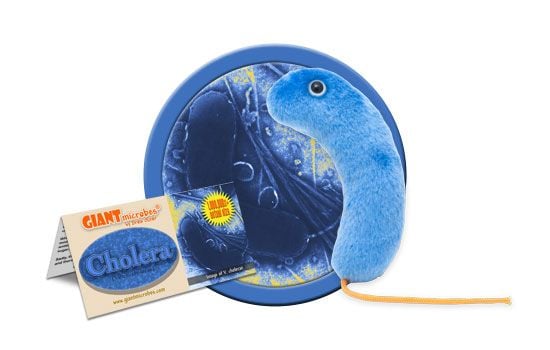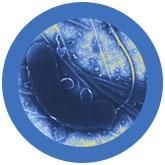Cholera (Vibrio cholerae)
Out of Stock
Product Details
Additional Information
| Sizes | Giantmicrobes are based on actual microbes, cells, organisms and other critters, only 1,000,000 times actual size! Gigantic (GG) 16-24" XL (XL) 10-15" Original (PD) 5-8" Keychain (KC) 2-4" with clip |
|---|---|
| Materials | Plush from all new materials. Stuffed with polyester fiber fill. Surface washable: sponge with water & soap, air dry. |
| Packaging | Each plush microbe includes a printed card with fun, educational and fascinating facts about the actual microbe or cell. |
| Safety | Every product meets or exceeds U.S. and European standards for safety. For ages 3 and up. |
All about Cholera (Vibrio cholerae)
FACTS: There was never a time when anyone loved cholera. And Gabriel García Márquez notwithstanding, the sufferings of romantic entanglements are only marginally comparable to those of V. cholerae infections.
When this water-borne bacteria pursues its victims, it produces a toxin that attacks the lining of the small intestine. Yes, the stomach-churning discomfort is vaguely reminiscent of the pangs of lovesickness – but less so the quick progression to unrelenting diarrhea and life-threatening low blood pressure. In addition, very few lovers suffer dehydration so severe that the body goes into shock, sometimes precipitating their demise in less than a day. While it’s true that passion can occasionally have tragic consequences, mortality rates are low compared with those of cholera infections which, if the disease is left untreated, can be as high as 60 %.
Fortunately, over the last 100 years, cholera has become increasingly scarce. Fecal matter is the prime carrier of cholera, and in nations that feature modern plumbing and water sanitation systems, cholera is now virtually unknown.
When it does occasionally appear, cholera is rarely a match for modern medicine: victims can receive proper hydration in a hospital – and antibiotics if necessary. (In a pinch, a homemade solution using water, sugar, table salt, baking soda, and fruit can help restore electrolyte levels.)
Sadly, the pains of love, unlike those of cholera, have yet to be plumbed – and there is no known cure.
| Name | Latin root word “vibro” describes the microbe’s vibrating movement patterns. Greek root word “chole” means bile and was used to describe dystentary and diarrhea. |
|---|
| Actual Size | 0.5 - 0.8 micrometers; 1000 times smaller than the period at the end of this sentence. |
|---|
| Where It Lives | Cholera is a disease of severe diarrhea and vomiting caused by a bacteria called Vibrio cholerae. V. cholerae live water and make a toxin that attacks the small intestine. It spreads through contaminated food and water, and it’s commonly found in developing countries where water sanitation is limited. |
|---|
| Symptoms | Diarrhea, vomiting, fever, and severe dehydration. |
|---|
| Cure | Rapid fluid replacement and antibiotics. |
|---|
| History |
1854: Filippo Pacini, an Italian scientist Big Outbreaks: 1817: First pandemic spreads throughout Asia. 1854: John Snow, a London physician known as the “father of epidemiology”, identified the outbreak source at the Broad Street pump. 1961: Seventh pandemic started in Indonesia and spread through Asia. Recent Outbreaks: 1991: Returned to South America after a century. 2010: Cholera outbreak in Haiti, following a devastating earthquake. |
|---|
| Fascinating Facts |
Raw oysters are a culinary delicacy, but these ocean filter feeders can contain V. cholerae! It’s recommended to wait until cold months to eat them when bacteria load is low. “Love in the Time of Cholera”, a novel written by Gabriel Garcia Marquez, actually had very little to do with the disease. The title compares suffering from love with suffering from cholera. Ouch! Famous people who died of it: 1849: James K. Polk, 11th President of the United States 1850: Zachary Taylor, 12th President of the Unite States |
|---|






